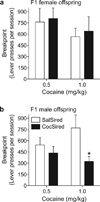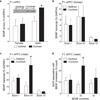Epigenetic inheritance of a cocaine-resistance phenotype
- PMID: 23242310
- PMCID: PMC3531046
- DOI: 10.1038/nn.3280
Epigenetic inheritance of a cocaine-resistance phenotype
Abstract
We delineated a heritable phenotype resulting from the self-administration of cocaine in rats. We observed delayed acquisition and reduced maintenance of cocaine self-administration in male, but not female, offspring of sires that self-administered cocaine. Brain-derived neurotrophic factor (Bdnf) mRNA and BDNF protein were increased in the medial prefrontal cortex (mPFC), and there was an increased association of acetylated histone H3 with Bdnf promoters in only the male offspring of cocaine-experienced sires. Administration of a BDNF receptor antagonist (the TrkB receptor antagonist ANA-12) reversed the diminished cocaine self-administration in male cocaine-sired rats. In addition, the association of acetylated histone H3 with Bdnf promoters was increased in the sperm of sires that self-administered cocaine. Collectively, these findings indicate that voluntary paternal ingestion of cocaine results in epigenetic reprogramming of the germline, having profound effects on mPFC gene expression and resistance to cocaine reinforcement in male offspring.
Figures






Comment in
-
Forgiving the sins of the fathers.Nat Neurosci. 2013 Jan;16(1):4-5. doi: 10.1038/nn.3288. Nat Neurosci. 2013. PMID: 23257926 Free PMC article.
References
Publication types
MeSH terms
Substances
Grants and funding
- K01 DA30445/DA/NIDA NIH HHS/United States
- R01 DA15214/DA/NIDA NIH HHS/United States
- R01 DA22339/DA/NIDA NIH HHS/United States
- T32 MH86599/MH/NIMH NIH HHS/United States
- R01 DA022339/DA/NIDA NIH HHS/United States
- R01 DA33641/DA/NIDA NIH HHS/United States
- F31 DA31535/DA/NIDA NIH HHS/United States
- K02 DA18678/DA/NIDA NIH HHS/United States
- K01 DA030445/DA/NIDA NIH HHS/United States
- K02 DA018678/DA/NIDA NIH HHS/United States
- T32 DA028874/DA/NIDA NIH HHS/United States
- F31 DA031535/DA/NIDA NIH HHS/United States
- R56 MH086599/MH/NIMH NIH HHS/United States
- T32 GM007517/GM/NIGMS NIH HHS/United States
- R01 DA033641/DA/NIDA NIH HHS/United States
- R01 DA015214/DA/NIDA NIH HHS/United States
- T32 DA28874/DA/NIDA NIH HHS/United States
- R01 MH086599/MH/NIMH NIH HHS/United States
LinkOut - more resources
Full Text Sources
Other Literature Sources

